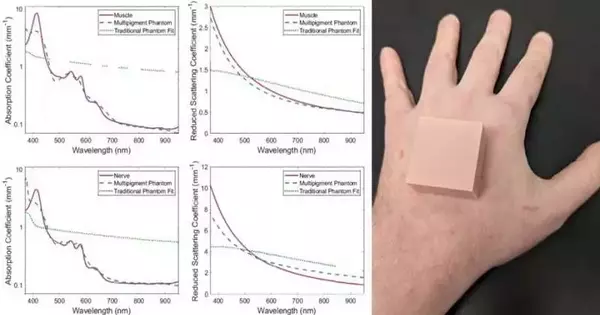When scientists develop new optical techniques and instruments for medical diagnosis, surgery, or light-based therapy, those techniques and instruments must be validated and calibrated through extensive testing. The test runs are usually performed on “optical phantoms,” objects specially designed to mimic a specific type of tissue. Phantoms facilitate several tasks, including calibration, assessment of a tool’s resolution, and post-processing algorithm validation.
While an ideal phantom should respond exactly like the target tissue across the entire optical spectrum, this is not achievable with current technology. Modern optical phantoms can only mimic some of the target tissue’s properties and only across a narrow band of wavelengths. Although this is sufficient for many imaging techniques, various emerging hybrid modalities and novel instruments depend on a wider band of wavelengths for tissue optical properties (e.g., absorption and scattering).
The situation calls for a new design of optical phantoms that can reproduce the representative tissue more faithfully. In a recent study published in the Journal of Biomedical Optics (JBO), researchers from Vanderbilt University in the U.S. came up with an innovative platform to produce such adaptive optical phantoms.
“Biomedical optical technologies are approaching phases of development that will necessitate a high degree of standardization to correspond to multiple industrial and regulatory norms, ultimately leading to clinical translation and adoption,”
Associate Editor Frédéric Leblond, professor of engineering physics at Polytechnique Montréal,
Their idea is centered around the addition of multiple pigments when fabricating a phantom, such that after the epoxy resin solidifies, the optical properties of the final material will accurately reflect those of the target tissue. The process is similar to how hardware store paints are made to match an arbitrary target color by combining a number of set pigments.
The researchers first characterized the optical response of 20 commercially available pigments when added individually to an epoxy resin sample at different concentrations. In this way, they quantified how much each pigment would contribute to the phantom’s scattering, baseline absorption, and absorption peaks at different wavelengths.
This, however, raised an important question: How much of each pigment is needed to match a given set of tissue properties? To answer this, the researchers used optimization techniques to calculate the best mixture of pigments for each case.
To showcase the performance of phantoms designed with their platform, they next conducted a series of extensive validation experiments. First, they produced phantoms matching the overall absorption and scattering of human muscle and nerve tissue taken from cadavers. Following this, they produced phantoms with different diffuse reflectance values, a relevant parameter in certain imaging techniques.
These phantoms successfully mimicked the diffuse reflectance of pale and melanistic skin types. Finally, the researchers used their multi-pigment approach to create phantoms that emulated specific concentrations of chromophores. In this case, the phantoms represented different levels of oxygen saturation in hemoglobin.
Overall, the results of the validation experiments look very promising, with the generated phantoms accurately matching the desired properties of the target tissue with minimal error.
“The method provided by the authors could become the new standard in the development of adaptive optical phantoms,” remarks JBO Associate Editor Frédéric Leblond, professor of engineering physics at Polytechnique Montréal, “and biomedical optics technologies are entering phases of development requiring a high degree of standardization to conform to various industry and regulatory standards, ultimately leading to clinical translation and adoption, so this work is timely and important.”
Put simply, this innovative platform could help solve the various phantom-related issues that are currently holding back new medical imaging technologies. Over time, this will translate to better optics-based diagnostics and treatments.
More information: Alec B. Walter et al, Development of a platform for broadband, spectra-fitted, tissue optical phantoms, Journal of Biomedical Optics (2023). DOI: 10.1117/1.JBO.28.2.025001





